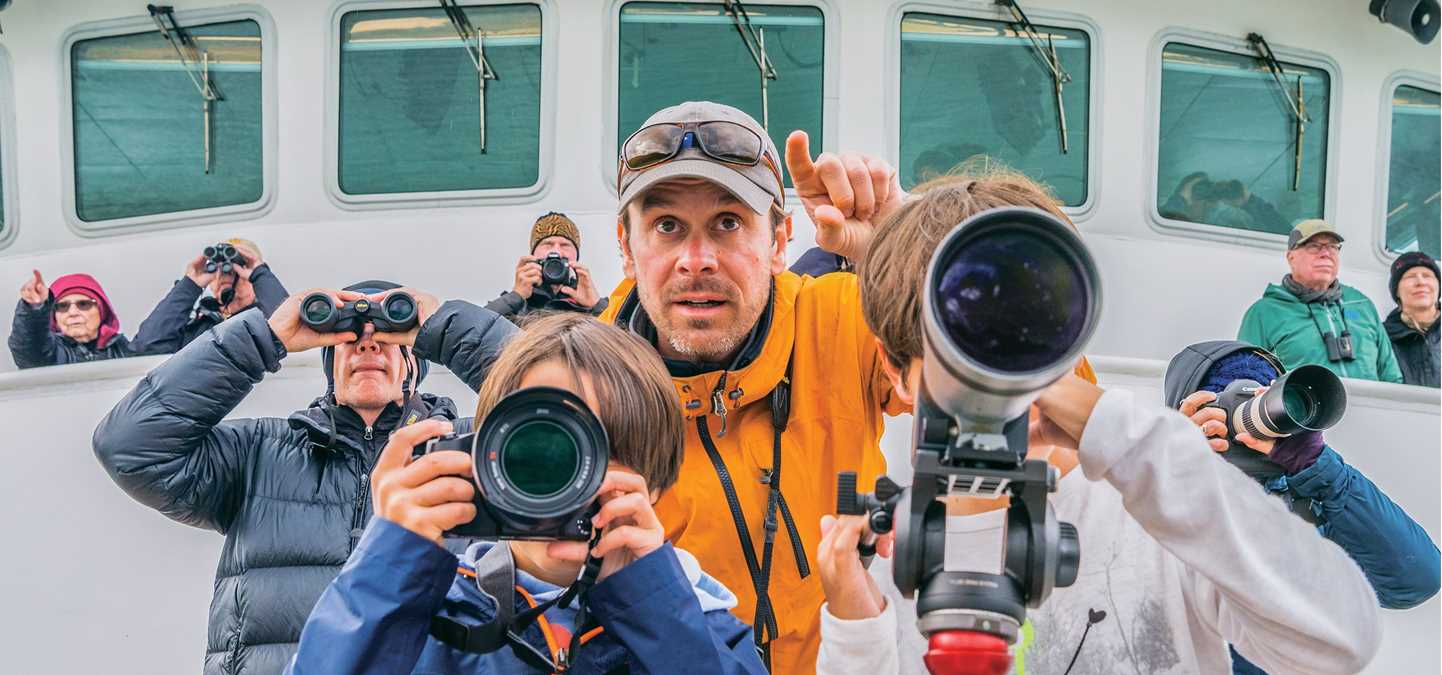Photo
Certified Photo Instructor
Photography is at the core of everything we do—after all, Sven Lindblad, our founder, began his career as a wildlife photographer. To help our guests take the best possible shots, a specially trained certified photo instructor joins every voyage to offer assistance with all of your photography needs, from camera settings to composition. Their goal is to help guests become better, more confident photographers—and to help them go home with amazing shots that tell the story of their journey.
Our photo instructors are also trained naturalists, which gives them advantage when it comes to photographing the natural world. They are well-versed in animal behavior and can coach guests as they prepare to photograph a bear fishing for salmon or a pod of killer whales on the hunt.
Photography is at the core of everything we do—after all, Sven Lindblad, our founder, began his career as a wildlife photographer. To help our guests take the best possible shots, a specially trained certified photo instructor joins every voyage to offer assistance with all of your photography needs, from camera settings to composition. Their goal is to help guests become better, more confident photographers—and to help them go home with amazing shots that tell the story of their journey. ...
Read more
Meet our Photo Instructors

Anna Mazurek
South Carolina native Anna Mazurek fell in love with traveling and photography while studying abroad in England during college. Since then, she’s been to 53 countries and lived in five. She is a freelance travel photographer and writer currently based in Austin, Texas. Her previous clients include the Wall Street Journal , Facebook, Rolling Stone, AFAR magazine and Google. She has a Master’s degree in photojournalism from the University of Missouri and a Bachelor’s degree in journalism from the University of South Carolina. She also teaches part-time at School of Journalism and Mass Communications at Texas State University. She managed student photo trips in Asia for five years and currently runs summer photo trips for National Geographic Student Expeditions. She doesn’t like to sit still and spends her time exploring the remote corners of the world including Mongolia and Easter Island. Some of her travel highlights including climbing Kilimanjaro and photographing the Dalai Lama at his temple in McLeod Ganj, India.
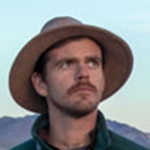
Alex Harper
Alex Harper is based in Southern Nevada, where he spends most of his time as a freelance naturalist, science communicator, birding guide, speaker, and writer. He serves on the board of directors for the Las Vegas-based Audubon chapter, as well as multiple committees for various organizations related to wildlife and habitat conservation. Alex did not imagine ending up in Las Vegas. He grew up between the mangrove bays and Florida Everglades in the Miami area. His free time as a kid was often spent getting bitten by lizards, climbing trees, and staining his clothes in estuarine mud. From an early age, he gravitated towards marine mammals, reptiles and amphibians, and birds. It would be birds that ultimately captivated his curiosity and became the primary focus of his interests. Over the course of his professional career, he has conducted bird population counts across the western United States for the National Park Service and the renewable energy industries, been a birding guide on the Pribilof Islands of Alaska and a remote Amazon lodge and counted migratory hawks in the Florida Keys. The desire to share the beauty of the natural world gets Alex out of bed in the morning. He believes that there is no shortage of opportunities to be moved by the natural world, to experience awe and wonder in it, and that it is through connecting people with nature that we can value it enough to preserve its functioning ecosystems. For this reason, he owns and operates Nature in Mind, a business that brings wellness and science together for kids and adults of all ages. Alex loves to swap stories and learn from his colleagues and Lindblad guests. Alex enjoys hiking, trail running, photography, reading, writing, and practicing mindfulness. He is grateful and proud to step foot on Lindblad ships to keep him wild.
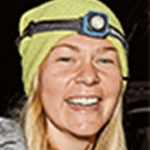
Brooke Juhala
At 6-years-old, Brooke knew she wanted to be an Expedition Photographer. So much so, she insisted her mother sign her up for drawing classes - just in case her camera broke in-the-field. Ever since, her love for storytelling has inspired her to pursue a life of adventure. Raised in Washington state, Brooke has since called many places “home.” After graduating from Northern Arizona University, Brooke moved to Thailand which led her to journeying solo through Bali and then backpacking alone for 16-days in Nepal, traveling by foot from Jiri to Gokyo Ri. Upon returning stateside, Brooke began leading cross country road trips for TrekAmerica. In 2016, she moved to Portland, OR where she guided for a local kayaking company, as well as REI as an Outdoor School Instructor. Here, Brooke became immersed in human-powered objectives. As she dove deeper into the adventure sports cultures - her photography portfolio began to expand. Now, Brooke is an internationally published Photojournalist and Filmmaker based in Seattle, WA. Her work has been featured by Rock & Ice, Climbing Magazine, and BBC. Outside of her creative endeavors, Brooke utilizes her technical outdoor skills by volunteering with Olympic Mountain Rescue. She looks forward to visiting some of the world’s most incredible destinations with her fellow teammates and guests of Lindblad Expeditions, and she’s keen to share her photography passion and experience to help make your journey even more memorable.
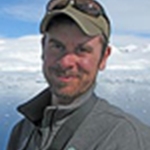
Eric Guth
Eric began work with Lindblad Expeditions-National Geographic in 2006 as a means to see the world, work with great photographers and engage his environmental studies degree beyond the classroom. His initial years with the company were spent working the waters of Southeast Alaska and Baja California. His move to the National Geographic Explore r in 2008 helped earn him the experience and knowledge needed to establish himself as a trusted boat handler, naturalist and respected photographer in nearly all the environments Lindblad-National Geographic travels. Eric’s extensive exposure to and long time passion for exploring/photographing glaciated areas has recently earned him the title “Ice Man” in media outlets the world over. While not at sea he is in the mountains searching for glacier caves, secluded vistas and other remote landscapes in which to photograph.

Nathan Kelley
Nathan Kelley developed his love for nature as a kid at his family’s cabin in Northern Wisconsin. Family fishing trips, camping, hiking and a trip to his first National Park in the Everglades, all vigorously shaped his passion for the natural world. After graduating with a degree in Cinema and Photography from Southern Illinois University in the heart of the Shawnee National Forest, he moved to Southern California to work as a camera operator and photographer in a wide range of projects including work for the National Geographic Society. Now living in Juneau, Alaska he has found the place his heart always belonged. His photography has also been exhibited in galleries and in publications. A strong desire for adventure led him to travel around the world learning new cultures and photographing the beauty in the diverse natural world we live in. Living and working in Southeast Alaska has allowed him to fine tune his creative eye, while educating his guests on photography tips and the ecology of the place he calls home. Nathan hopes his photography, knowledge and passion will inspire others to explore and stand up for the planet.
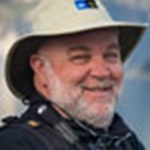
Doug Gould
Travel and adventure were an integral part of Doug’s upbringing in a small town on the south shore of Long Island, New York. Growing up on the Great South Bay, his family claims Doug learned to sail before he learned to walk. Whether it was camping, sailing, birding, traveling across country or spending most of fifth grade living in Europe, Doug’s formative years left him with a love of wildlife, the outdoors, and a desire to keep moving. After receiving a B.A. in dramatic arts from the University of California, Santa Barbara, Doug mixed a short career in the film and TV industry with two summers working for the Catalina Island Harbor Patrol, which led to his owning the third largest private marine rescue company in California. Doug sat on the Board of Directors of the Vessel Assist Association of America for three years and has lectured extensively to the marine assistance industry about safety and risk management. In 2003, he volunteered to work for Oceanites as a member of their Antarctic Site Inventory wildlife census team (aka: a penguin counter). This opportunity included numerous trips to the Antarctic Peninsula over the span of three seasons. The Antarctic Site Inventory focused on gathering data about the impact of tourism on Antarctic wildlife, and helped to develop some of the Antarctic Treaty recommendations that govern tourism today. Since 2011, Doug has worked full time as a naturalist, photographer and expedition leader, working primarily in the polar regions. In 2015 he joined Lindblad Expeditions, and continues to share his enthusiasm for travel and adventure as an expedition leader and certified photo instructor.
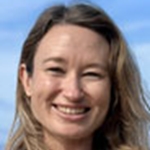
Chelsea Mayer
Chelsea is a naturalist, photographer, and videographer whose love of animals is the through line in her life. She grew up on the southern California coast in Huntington Beach, and throughout her teenage years she volunteered at an animal shelter and a wildlife rehabilitation center. In 2011 she graduated from UCLA’s School of Theater, Film and Television with a Bachelor of Arts in Film Production. After a few years of working on films, Chelsea turned her sights seaward, leaving Los Angeles in favor of a career on the open ocean. Nearly every day for three years, Chelsea had the privilege of observing the marine mammals of southern California, working as a naturalist, photographer and deckhand aboard various whale watching boats in Orange County. More recently, Chelsea moved to San Diego, and trained to be a scuba diving professional. She works as a divemaster on a liveaboard vessel that does scuba diving trips to the Channel Islands, and great white shark cage diving at Guadalupe Island. She loves working on boats because she gets to meet interesting people from all over the world and share her enthusiasm for nature and conservation. Chelsea is a US Coast Guard-licensed 100-ton Captain, PADI Divemaster, American Cetacean Society Naturalist, and Girls Who Click Ambassador.
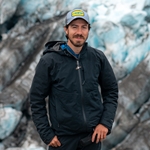
Brady Clarke
Brady Clarke grew up with an irrational fear of the ocean and a strong dislike for biology - being a naturalist on expedition vessels was far from his plan. As he entered the first year of his undergraduate degree at the University of New Hampshire, a professor ignited a passion for marine science and storytelling leading to his decision to pursue a Bachelor of Science in Marine, Estuarine, and Freshwater Biology. From there, his newfound passion led him to the Pacific Northwest to work for marine science organizations, expedition companies, and nonprofits where he focused on visual storytelling to inspire action. In 2023 Brady moved to New Zealand to pursue a Master's Degree in Science Communication and Natural History Filmmaking from the University of Otago. There, he used filmmaking to amplify the voices of conservation groups, indigenous communities, and research teams, bringing their stories into the spotlight. His films have reached thousands worldwide, been showcased in museums and theaters, and won numerous awards at film festivals. From leading expeditions and wildlife tours to filming conservation stories on remote islands, Brady has dedicated his life to telling stories that would otherwise go unnoticed and inspiring others to care for our planet.
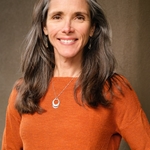
Jennifer Davidson
Jennifer Davidson is a photographer and educator who specializes in travel, culture, and the art of visual storytelling. She has photographed across the globe, including extensively in Colombia, where she documented remote fishing villages, and Ecuador, where she focused her lens on indigenous cultures in the highland and Amazon regions. Jennifer’s work in South America and the Galapagos Islands has been featured in National Geographic Traveller (UK). Since 2008, she has taught photography through National Geographic Expeditions to a variety of aspiring photographers. She has led photography workshops throughout the United States and photo expeditions in Alaska, Baja California, Cuba, Galapagos, the Mediterranean, and Southeast Asia, among other destinations. Jennifer enjoys inspiring photographers to experience the world in new ways through their cameras. When she’s not traveling, she can often be found wandering mountain trails outside her Santa Fe, New Mexico home.
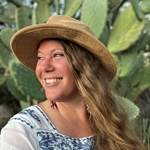
Gemina Garland-Lewis
Gemina Garland-Lewis is a professional documentary photographer based in Baja California Sur, Mexico, with experience in over 30 countries across seven continents. Her photography explores the myriad connections between humans, animals, and their shared environments, focusing on impact-driven storytelling techniques. She first picked up a camera when she was 12 years old and proceeded to spend the better part of high school in the darkroom in her hometown of Santa Fe, New Mexico. She is passionate about integrating the worlds of visual storytelling, community engagement and research to develop new ways of communicating social and environmental issues to broader audiences and building unique platforms for education and outreach. She is a National Geographic Explorer, receiving a grant for her photography project in the Azores from the National Geographic Society in 2012. Gemina completed her Masters degree in Conservation Medicine at Tufts University in 2013 and has worked alongside the Center for One Health Research at the University of Washington since, focusing on health and disease issues at the human-animal-environment interface and ways to integrate visual storytelling into this field. She loves working in photo education and began teaching photography for National Geographic Student Expeditions in 2010. She has been with Lindblad Expeditions since 2019. Her photography and writing have been published by National Geographic, bioGraphic, NPR, The Washington Post, and REI, among others. Gemina is an avid outdoor adventurer and environmental stewardship advocate. You will likely find her somewhere in the mountains or on the ocean, chasing the light with camera in tow and a silly grin on her face.
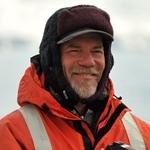
David Cothran
David has worked for Lindblad Expeditions-National Geographic since 1993 on six continents and in over 65 countries. David is interested in many of the natural sciences, particularly ornithology, geology and marine biology; he most enjoys contrasting the broad perspectives provided by world travel with detailed investigations of local ecosystems on land and in the sea. David is an avid wildlife and landscape photographer and enjoys shooting with DSLRs, compact cameras and his iPhone. He particularly focuses on photography of wildlife in habitat, macro images of insects and abstracts images of patterns and textures. Before joining Lindblad-National Geographic, David worked as a staff field biologist and education coordinator at the Point Reyes Bird Observatory, an independent research institution in California. At PRBO David studied songbirds, seabirds, owls and elephant seals while overseeing a broad education program, which included classes for school-children, workshops for professional biologists and interpretation for the general public. His home, which is completely off the grid, is at the crest of the Siskiyou Mountains in southern Oregon. He received his Photo Instructor certification in a multi-day training workshop. Developed and taught by National Geographic and Lindblad Expeditions photographers, the workshop helped him develop additional insight and skills necessary to help you better understand your camera and the basics of composition — to better capture the moments at the heart of your expedition.

Andrew Peacock
Andrew was born in Adelaide, South Australia and (mis)spent his youth surfing and kayaking in the ocean, as is the case for many Aussies! After graduating from medical school, he spent a year working as a surgical resident in Santa Barbara, California where he also began rock climbing. Taking up this new activity with a passion, Andrew began to explore the mountainous regions of the world and volunteered his medical skills in Nepal and India where he has since led numerous treks. Documenting his experiences with a camera led Andrew into the world of professional photography and he began contributing photos to what was then the Lonely Planet image library. So began a ‘sideline career’ using the creative side of his brain. In the years since Andrew has carved out a unique niche for himself as an expedition and wilderness physician, expedition leader, and nature photographer with multiple journeys across all of the continents. His images are published widely for commercial use and Andrew enjoys nothing more than combining his outdoor adventure and leadership skills with medical and/or photography work in far-flung locations of the globe. In 2017 he spent a month as a volunteer medical ranger with the National Park Service in Alaska high on the slopes of Denali, North America’s highest mountain.
Showing 12 of 22

